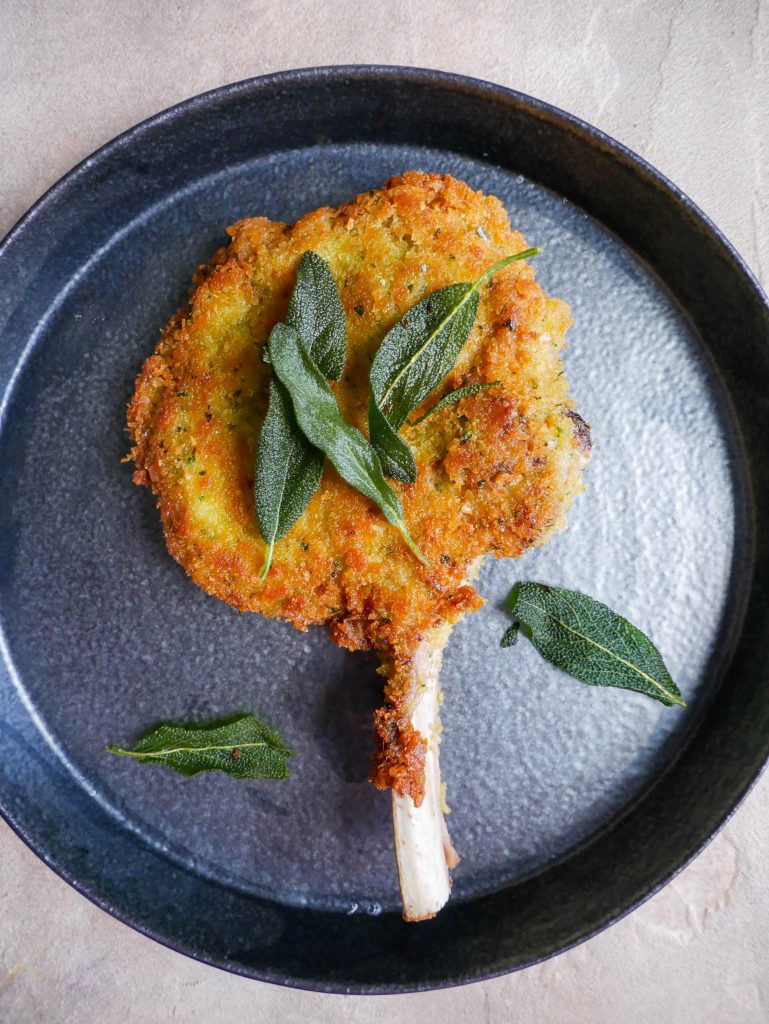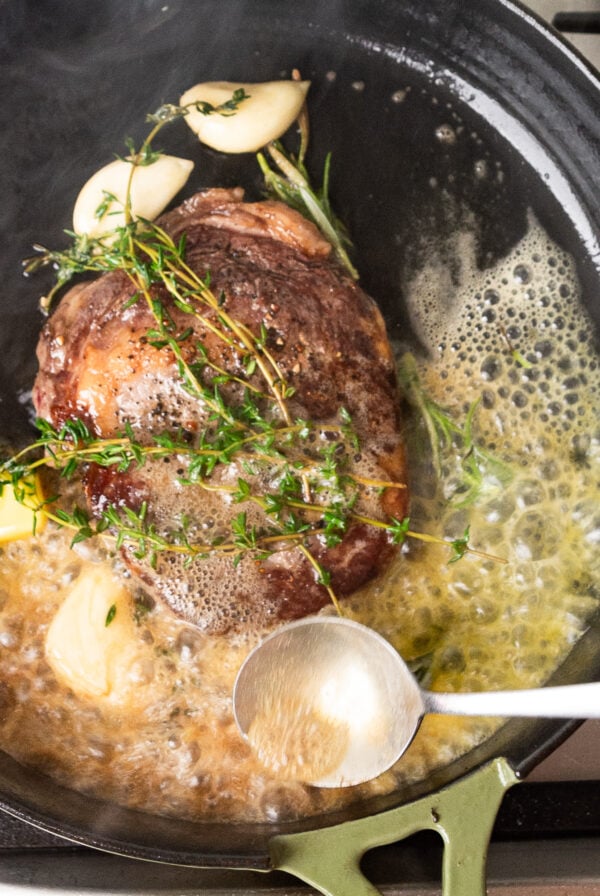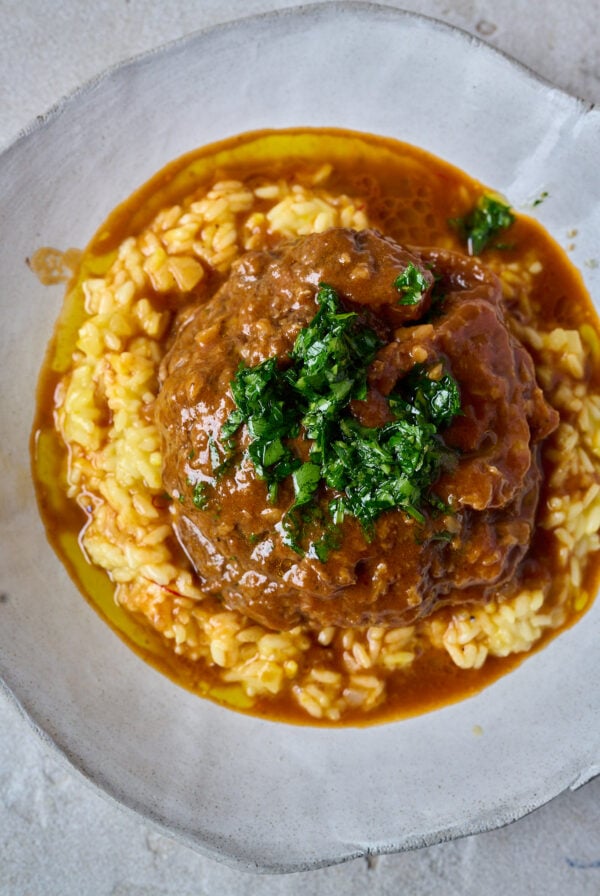Veal Cotoletta or Cotoletta alla Milanese
Sep 29, 2022, Updated Feb 26, 2025
Jump to RecipeThis post may contain affiliate links. Please see our disclosure policy.
Veal cotoletta or cotoletta alla Milanese is a special and culturally important meal in any Italian family’s home. It’s a veal cutlet that has been breaded and fried to golden and crispy perfection.

Veal Cotoletta or Cotoletta alla Milanese
Veal is the meat from a young calf and is extremely tender to eat. As my mum describes it, veal is a joy to the mouth. Cotoletta alla Milanese is an Italian dish that originated in Milan. Traditionally, a piece of veal cutlet is crumbed and fried in clarified butter or ghee. Every Italian family has put their own personal spin on this dish. We like to fry our veal cutlet in olive oil as it gives it a lovely golden colour and mild fruity flavour throughout. When cooking your cotoletta, you want the meat to have a blushing shade of pink on the inside.
Breadcrumbs
I know it can be so easy to resort to pre-made or panko breadcrumbs but these homemade breadcrumbs are truly worth it. They are simplicity at its best with only three ingredients needed to make them. A whole bunch of parsley and a touch of fresh rosemary is blended together with stale bread. This results in a breadcrumb that is chunky and the most lovely green colour. Be sure to use the crust of the bread when making your breadcrumbs as it’s those chunky pieces that create the crispiest layer. It’s important the bread you are using is not fresh and is several days old or has been slightly dried out as fresh bread will be too moist resulting in a breadcrumb that doesn’t stick to your meat. I can assure you that you will not find breadcrumbs like this at the grocer! I also use these breadcrumbs to make my crispy crumbed chicken.
Frequently Asked Questions
What do I do with the leftover oil?
If you have any remaining olive oil, store it in an airtight jar in your pantry for several weeks and use for frying meats. It can be reused 1 more time after its initial use. If you still have remaining olive oil after the second time of use, dig a hole in your garden and bury the oil.
What do I do if my bread is fresh?
It’s really important that your bread is stale when making the breadcrumbs. You have bought your bread the day before, you can lay it onto baking trays and leave it on your kitchen counter to dry out overnight. If it’s the day of, lightly toast your bread and allow it to cool.
How do you store the veal cutlet?
If you are making your cutlets in a large batch or have any leftover, wrap the crumbed cutlets individually in glad wrap and place in the freezer for up to 2 months.
Why do you use olive oil for shallow frying?
I use a light olive oil to shallow fry as it creates a lovely flavour and colour throughout the chicken. If you don’t want to shallow fry with olive oil, I recommend using grapeseed oil or a mix of light olive oil and grapeseed.
If you make this recipe, please tag me on Instagram, Tik Tok or Pinterest so I can see your wonderful creations!
If you have any questions or would like to leave a review, please do so here! I always love answering your food and recipe related questions and hearing your feedback on my recipes.

Veal Cotoletta
Ingredients
- 2 veal cutlets
- 8 - 10 slices white sandwich loaf
- 4 garlic cloves, crushed
- 4 eggs
- 1/2 cup flour, white all purpose
- 1 tsp flakey sea salt
- 1 tsp black pepper
- 1/2 bunch fresh parsley, stalks discarded
- 6 rosemary leaves
- 1/2 bunch fresh sage
- olive oil
Instructions
- Lay the bread out onto a baking tray and leave to dry out overnight. It’s important your bread has been dried out or is a few days old and stale as this will give you the crispiest breadcrumbs.
- Begin by making your egg wash. In a shallow wide bowl, whisk your eggs and garlic together and set to the side. By preparing this early the garlic will have time to release its flavour into the eggs.
- Place the veal cutlet between two pieces of plastic wrap. Using the smooth side of a mallet, pound the cutlets from the centre outwards, avoiding the bone, until the cutlet is roughly 1.5cm thick and has been tenderised. This step is to ensure the veal cooks at an even rate. Place your veal cutlets onto a plate and generously season both sides with salt and pepper. Set to the side.
- Roughly tear apart your bread and place into a food processor or blender with the parsley and rosemary. Blend until the bread is still quite fine and crumbly and the herbs have been mixed throughl. If you are using a small blender you will need to do this step in batches. Place your breadcrumbs into a large bowl.
- In a shallow wide bowl, whisk together the flour, salt and pepper and then set up your dredging station. Begin with your flour, followed by the egg wash, followed by the breadcrumbs and then finished with a large clean plate or tray to place the crumbed veal on. Take one veal cutlet and coat both sides evenly with the flour. Then place into the egg wash and coat both sides evenly. Lastly, place into the breadcrumb mixture applying pressure with your hands when you flip the veal over to ensure the breadcrumbs are evenly coated all over. Place the veal onto the clean plate and then repeat this step with the remainder of the veal. Place the veal into the fridge for 30 - 60 minutes to allow the breadcrumbs to set and bring the meat to a cold temperature. This will ensure the meat does not overcook when frying.
- In a large frying pan, add a very generous amount of olive oil until it's about 2 - 3cm deep in the pan. Bring the olive oil to heat. You can check if the olive oil is hot enough by placing a wooden skewer into it and seeing if bubbles form around the skewer. Turn the heat down to medium and fry 1 - 2 pieces of veal cutlets at a time for 3 - 4 minutes on one side on each side or until they are golden and crispy. It’s best to test out one piece of veal to make sure your cook time and heat levels are accurate. Remember your veal will continue to cook when you take it off the heat so take it off a few seconds before you feel it’s ready. Place the veal to rest onto a cooling rack so the oil can drip off and the bottom does not get soggy.
- Fry the sage leaves in the remaining olive oil for several minutes or until crispy. Scoop out with a slotted spoon and place onto a plate lined with absorbent paper.
Video
 Like this? Leave a comment below!
Like this? Leave a comment below!





